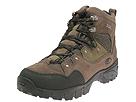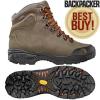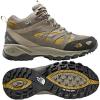
Hiking Boot Guide
Types of Hiking Boots

 |
Hiking Boot Guide
|
 |
| Home > Hiking Gear > Hiking Boots > Types of Hiking Boots | Search Site |
Hiking Boots
Hiking Gear
|
Types of Hiking Boots
|
 |
| An example of a good hiking boot for day hiking - not too too or heavy, but solid in ankle support |
It is truly quite amazing how many people stumble around the mountains of Montana without wearing any sort of hiking boot at all. So it is no surprise that all too many of these people end up hobbling back to their car at the end of the day with a twisted ankle or a tweaked knee.
If you're reading this page, hopefully you're looking for a hiking boot - so you don't end up a rescue statistic for Glacier National Park or the Forest Service. So...to help you get the right boot, this page will go over the three different types of hiking boots that are out on the market today. With a little luck, you'll end up with a better idea of what kind of boot to get for the type of hiking you do. So let's get started.
There are, at the end of the day, three types of footwear designed specifically for hiking. While many varieties of "work boots" work ok for day hiking, once you use a dedicated hiking boot, you'll wonder why you ever used a big, old, heavy work boot.
The Day Hiking Boot
 |
| A typical day hiking boot |
Typically, a good day hiking boot will provide solid ankle support - so solid that you can't roll over the ankle while standing in them - including when you wear a light pack.
Common threads of most good day hiking boots is that they weigh less than 3.5 pounds per pair. Day hiking boots will also share the same superb traction found on their larger cousins, the backpacking boot. And finally, most good day hiking boots are also fully waterproof, having a gore-tex membrance applied around the shell of the boot.
Backpacking Boots - The "Frankenstein" of Boots
 |
| The Big, bad backpacking boot. Note how high they extend up. |
Backpacking boots are the big, heavy hitters of the boot world. Backpacking boots have been specifically designed to provide absolute rock solid ankle support, even when you are carrying a pack that weighs more than 50 pounds. The boots are also exceptionally durable - more than a few pair have survived in fine style a hike up the Applachian and Sierra Crest Trails, something a day hiking boot would have trouble emulating.
Additionally, backpacking boots tend to have a bit more insulation in them as well as a bit larger of a sole than do day hiking boots. The result is that backpacking boots are heavy - frequently topping the scales between 5-6 pounds per pair!
And finally, backpacking boots tend to be usually primarily made of leather - another reason they tend to be a bit heavier than their day hiking boot cousins (which are generally a mix of fabric and leather). Leather is exceptionally durable - the reason it is used in backpacking boots. However, the leather DOES require treatment from time to time, both to keep the leather smooth (and to prevent cracking) as well as to keep the boots waterproof. So there is some additional maintenance required on backpacking boots. By contrast, with day hiking boots, other than an occasional cleaning, you can pretty much toss the boots in the closet and forget about them until your next hike.
Now, backpacking boots DO work quite fine for day hiking too. However, they are overkill for virtually all day hiking situations - as a good day hiking boot can handle the exact same type of terrain (just with less of a load) - and do so more comfotably.
So, here's a piece of advice. If you can only afford one pair of boots for tromping around the mountains, and you will be doing a mix of day hiking and overnight backpacking, then get a backpacking boot. However, if you don't really see yourself carrying a 50 pound back for overnight backpacking, stick with a day hiking boot. The boot may not be quite as durable and truly functional as a backpacking boot, but it will be far more enjoyable and comfortable to use on a day to day basis!
The Hiking Shoe - Oh, NO! |
| The Hiking Shoe - a big no, no for mountain hiking |
The dreaded hiking shoes. Hmm....not sure where to begin with this dreadful creation. Well, ok, not dreadful, really. These are fine shoes for around town stuff, casual and long walks in local parks, around town and over flatter areas where the terrain is even.
But, sadly, all too many people are using these hiking shoes as hiking boots - a big no, no. Yes, hiking shoes are amazingly comfortable. And they are far more durable than a sneaker. But, they provide absolutely no ankle support whatsoever. After all, at the end of the day, a hiking shoe is nothing more than a glorified sneaker hiding behind some different fabrics and with a different look.
So, if you plan on hiking in the mountains, please do your ankles, knees and legs a favor and hike in REAL boots - not some hiking shoe. Feel free to use the hiking shoe on flat, short hikes in even terrain, use them around camp, whatever. Just don't use them when taking long walks up and down the mountain in rocky terrain - as using them is a recipe for some nasty injuries sooner or later.l
Next Page : Other Considerations When Shopping for Hiking Boots
|
Copyright 2002-2018 |
![]()
| Montana Web Cams | Montana Information | Fly Fishing Gear | Fishing Boats | About | Contact Us | Advertising Information | Privacy Policy |